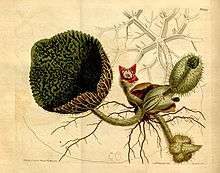Euryale ferox
Euryale ferox (common names prickly waterlily,[1] fox nut, foxnut, gorgon nut or makhana) is the only extant species in the genus Euryale. It is a flowering plant classified in the water lily family, Nymphaeaceae, although it is occasionally regarded as a distinct family, Euryalaceae. Unlike other water lilies, the pollen grains of Euryale have three nuclei.[2]
| Euryale ferox | |
|---|---|
 | |
| Illustration of Euryale ferox from Curtis's Botanical Magazine (1812). | |
| Scientific classification | |
| Kingdom: | Plantae |
| Clade: | Tracheophytes |
| Clade: | Angiosperms |
| Order: | Nymphaeales |
| Family: | Nymphaeaceae |
| Genus: | Euryale Salisb. |
| Species: | E. ferox |
| Binomial name | |
| Euryale ferox | |


Growth
Makhana or Euryale is a perennial plant native to eastern Asia and southern Asia , and is found from India - Bihar in nine districts viz, Madhubani, Darbhanga, Katihar, Sitamarhi, Purnea, Kishanganj, Araria, Saharsa and Supaul (local name Makhana) and valley and some hilly areas of Manipur (local name Thangzing) - to Korea and Japan, as well as parts of eastern Russia. Bihar produces 90% of the world production of fox nut.[4] It grows in water, producing bright purple flowers. The leaves are large and round, often more than a meter (3 feet) across, with a leaf stalk attached in the centre of the lower surface. The underside of the leaf is purplish, while the upper surface is green. The leaves have a quilted texture, although the stems, flowers, and leaves which float on the surface are covered in sharp prickles. Other leaves are submerged. In India, Euryale normally grows in ponds, wetlands etc. Recently the Indian Council of Agricultural Research has developed a technique for the field cultivation of Euryale.
Uses
Culinary
The plant produces starchy white seeds that are edible. The plant is cultivated for its seeds[4] in lowland ponds in India, China, and Japan. The Chinese have cultivated the plant for centuries.[5] More than 96,000 hectares of Bihar, India, were set aside for cultivation of Euryale in 1990-1991.[3] The plant grows best in locations with hot, dry summers and cold winters. Seeds are collected in the late summer and early autumn, and may be eaten raw or cooked.
In India, in the northern (Punjab) and western parts of the country, Euryale ferox seeds are often roasted or fried, which causes them to pop like popcorn. These are then eaten, often with a sprinkling of oil and spices. It is used in cooking, especially to make a porridge or pudding called kheer.
Evidence from archaeobotany indicates that Euryale ferox was a frequently collected wild food source during the Neolithic period in the Yangtze region, with large numbers of finds coming from the sites of Kuahuqiao, Hemudu, and Tianluoshan.[6] The earliest recorded use of E. ferox was found in Gesher Benot Ya'aqov, Israel, among artifacts of the Acheulean culture 790-750,000 years ago.[7]
The seeds are used in Cantonese soup. [8]
Traditional medicine
The seeds of foxnut are used in Ayurveda preparations and in traditional Chinese medicine.[4]
References
- Lee, Sangtae; Chang, Kae Sun, eds. (2015). English Names for Korean Native Plants (PDF). Pocheon: Korea National Arboretum. p. 466. ISBN 978-89-97450-98-5. Retrieved 7 March 2019 – via Korea Forest Service.
- Cronquist, Arthur (1981). An Integrated System of Classification of Flowering Plants. New York: Columbia University Press. p. 111. ISBN 978-0-231-03880-5.
- Lariushin, Boriss (2012). Solanaceae family. p. 17. ISBN 9781478191834.
- Flora of China, "Euryale ferox"
- Mabberley, D. J. (1987). The Plant-book. Cambridge: Cambridge University Press. ISBN 978-0-521-34060-1.
- Fuller, D. Q.; Qin, L; Zheng, Y; Zhao, Z; Chen, X; Hosoya, LA; Sun, GP; et al. (2009). "The Domestication Process and Domestication Rate in Rice: Spikelet bases from the Lower Yangtze". Science. 323 (5921): 1607–1610. doi:10.1126/science.1166605. PMID 19299619.
- Goren - Inbarand, N.; Melamed, Y.; Zohar, I.; Akhilesh, K.; Pappu, S. (2014-10-11). "Beneath Still Waters - Multistage Aquatic Exploitation of Euryale ferox (Salisb.) during the Acheulian". Internet Archaeology (37). doi:10.11141/ia.37.1. Retrieved 16 October 2014.
- Yujing Liu; et al. (2018). "Plants traditionally used to make Cantonese slow-cooked soup in China". Journal of Ethnobiology and Ethnomedicine. 14 (1): 4. doi:10.1186/s13002-018-0206-y. PMC 5769313. PMID 29334976.
External links
| Wikispecies has information related to Euryale (Nymphaeaceae) |
| Wikimedia Commons has media related to Euryale ferox. |